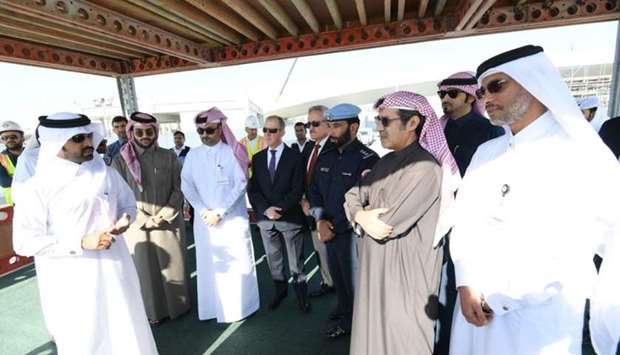The 362m-long underpass with two lanes in each direction connects with a 428m-long section of Al Rayyan Al Jadeed Street and 210m-long section of Al Shahama Street, and will accommodate up to 4,000 vehicles per hour, Ashghal has said in a press statement.
The Bani Hajer underpass will be a key access point in the area, largely serving residents of Bani Hajer and Al Rayyan, as it will connect Al Shahama Street in Bani Hajer with Al Rayyan Al Jadeed Street in Al Rayyan, the statement explains.
Road users travelling from Al Shahama Street can now enjoy direct access via the free-flowing underpass to Al Rayyan Al Jadeed Street and Al Rayyan and vice-versa.

A view of the newly opened bridge at Bani Hajer
The opening was held in the presence of senior officials from Ashghal and the General Directorate of Traffic. Among those present were Ashghal director of Infrastructure Affairs Mohamed Masoud al-Marri, and Captain Nasser Ghalib al-Dusari, from Patrol Section at the General Directorate of Traffic, along with a number of engineers and senior staff from Ashghal.
As part of the delivery, Ashghal has installed all necessary utility works, including drainage systems as well as lights and signage, to ensure the safety of road users.
Al-Marri said the opening of the Bani Hajer underpass would improve traffic flow in the area, especially after removing the diversion that was used to make U-turns for traffic coming to and from Bani Hajer and Al Rayyan, noting that road users would be able to go straight through the underpass.

The new underpass is part of the Bani Hajer Interchange reconstruction, which upon completion in March will be a key feeder connecting traffic Doha, Dukhan, Bani Hajer and Al Rayyan.
Al-Marri said the Bani Hajer interchange consists of three levels with four underpasses, two loops, two link bridges and a right-turn road linking traffic coming from Dukhan towards Al Rayyan.
Captain al-Dusari stressed that the underpass will serve residents in the areas of Bani Hajer and Al Rayyan as it connects Al Shahama Street with Al Rayyan Al Jadeed Street, providing easy traffic movement in both directions.
Ashghal had earlier opened a 3.1km-long section of the Khalifa Avenue main carriageway (full length on completion will be 7.3km) spanning from the west of Tilted Interchange to the east of Bani Hajer Interchange.
The opening has alleviated traffic congestion on the main road and the local approaches in Al Gharafa and Bani Hajer and improved traffic movement for the residents there, the statement adds.
Ashghal also opened Al Wajbah Bridge after upgrading the old bridge from two lanes into three lanes, allowing for better traffic flow.
A first in Qatar, an "innovatively designed roundabout" has also been opened: the main road - which is the straight section for traffic on Khalifa Avenue - goes through the centre of the signallised roundabout.
The interchange links north Gharafat al-Rayyan Street, south Qatar Foundation and west and east Al Luqta Street.
The Khalifa Avenue project runs from the Al Wajbah Palace Interchange (west) to the Tilted Interchange (east) and along Al Gharafa Road from Al Rayyan Street (south) to Thani bin Jassim Street (north).
The project works include the construction of approximately 11.6km of dual carriageway with four lanes in each direction replacing a three-lane way besides seven major free-flowing interchanges, service roads and auxiliary lanes along sections of the road.

Ashghal and Directorate of Traffic officials at the opening of the Bani Hajer underpass.
The Public Works Authority (Ashghal) has announced the opening of the Bani Hajer Underpass as part of the Bani Hajer Interchange on the Khalifa Avenue project.


